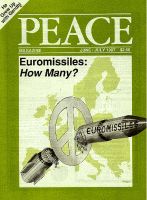
Peace Magazine Jun-Jul 1987, page 33. Some rights reserved.
Search for other articles by David Webster here
Nigel Hawks, Geoffrey Lean, David Leigh, Robin McKie, Peter Pringle, Andrew Wilson. London: Pan Books, 1986
The first book to be released after Chernobyl, The Worst Accident was written by journalists from The Observer of London and released as a mass market paperback. The authors have avoided what must have been considerable temptation to sensationalize the disaster.
Chernobyl caught the Soviet Union totally by surprise. As in the West, officials had convinced themselves that nuclear power was completely safe and the only possible road for the future of Russia and the world. Confident predictions were made that "by the end of the next century, two thirds of all power consumed in the world will be generated by nuclear plants." The odds given for a meltdown at a Soviet nuclear power plant were one in ten thousand years -- the same odds, interestingly, now being given by Ontario Hydro for its Candu reactors.
A class of technocrats, the so-called Red Specialists, promoted reliance on nuclear plants, in line with Lenin's adage that "communism is Soviet power plus the electrification of the whole country." The periods of favor of the Red Specialists (as under Stalin and Brezhnev) coincide with the periods of nuclear power development. When the Red Specialists were out of favor, as they were during the Khrushchev government, nuclear power development lapsed. The Worst Accident questions whether events have been very different in the West.
The answer comes from an historical overview. The authors outline the development of nuclear power from its early role as plutonium producer for nuclear weapons programs, through the "peaceful Atoms" era of the 1950's and the subsequent depression in the industry to the state of the nuclear industry today. They discuss the three great disasters of the pre-Chernobyl nuclear age -- the near meltdown at Britain's Windscale reactor in 1957, the chemical explosion in radioactive wastes at Kyshtym in the Russian Urals in late 1957 or early 1958, and the 1979 accident at Three Mile Island in Pennsylvania -- and find little difference in government handing of the disasters in the three countries.
The USSR has yet to admit the events at Kyshtym which were revealed in the West by a Soviet biochemist now living in England, Zhores Medvedev, in his book Nuclear Disaster in the Urals. The authors of The Worst Accident attribute this secrecy to the use of the Kyshtym plant by the ministry responsible for the nuclear weapons program. Ten years after the explosion, pregnant women were being advised to have abortions, food was still being checked for radioactivity, and fishing was still forbidden.
The military also had a band in the Chernobyl reactor complex. Soviet reactors are of two types -- the pressurized water reactor (similar to American reactors) and the Chernobyl type, which can be used to generate weapons grade plutonium. For this reason, the latter is not exported to Soviet allies, while the pressurized water reactor is.
The most interesting part of the hook is its description of world reactions to the disaster. The country most affected by early radiation, Poland, did not make information available to its citizens. It was left to the underground organization KOS to circulate a fact sheet on radiation and to the independent Freedom and Peace movement to denounce Poland's nuclear program.
Other Eastern Bloc governments tried to conceal the magnitude of the radiation and agreed, in a joint statement of Warsaw Treaty member states, to push on with their nuclear programs as if Chernobyl hadn't happened. Only independent Yugoslavia reacted to environmentalist protest and cancelled plans to build a second reactor.
The Worst Accident faults Western governments to nearly the same extent. France denied that radiation was significantly higher than normal. The behavior of the British government was little better and the United States, of course, used Chernobyl to try to discredit the USSR and its leader Mikhail Gorbachev. The book paints a vivid picture of American espionage related to the disaster which extended even to suggesting, in response to Swedish questions, that increased radiation levels on April 27 might be due to a Soviet nuclear test. This suggestion despite the Soviet moratorium on testing which was then still in force.
The central thesis is that Chernobyl marked "the end of the nuclear dream." To support this they cite the phasing out of nuclear power in Sweden, the cancellation of nuclear programs in the Philippines, Austria and other west European countries, and the slow death of the nuclear industry in the U.S. Yet, Ontario continues building Darlington and Hydro refuses to rule out more nuclear plants. In January 1987, Soviet News and Views (published by the Soviet Embassy in Ottawa) a Soviet government statement vowed to double nuclear power output by 1990. France, the most heavily nuclearized country in the world, has reaffirmed its commitment to nuclear power. The nuclear industry can only be described as "down but not out" -- something that could have been said before Chernobyl. The Observer news team has been too hasty to count it out.

Peace Magazine Jun-Jul 1987, page 33. Some rights reserved.
Search for other articles by David Webster here